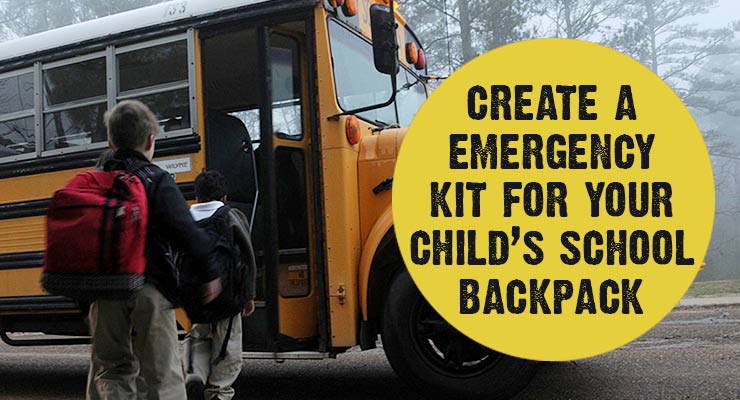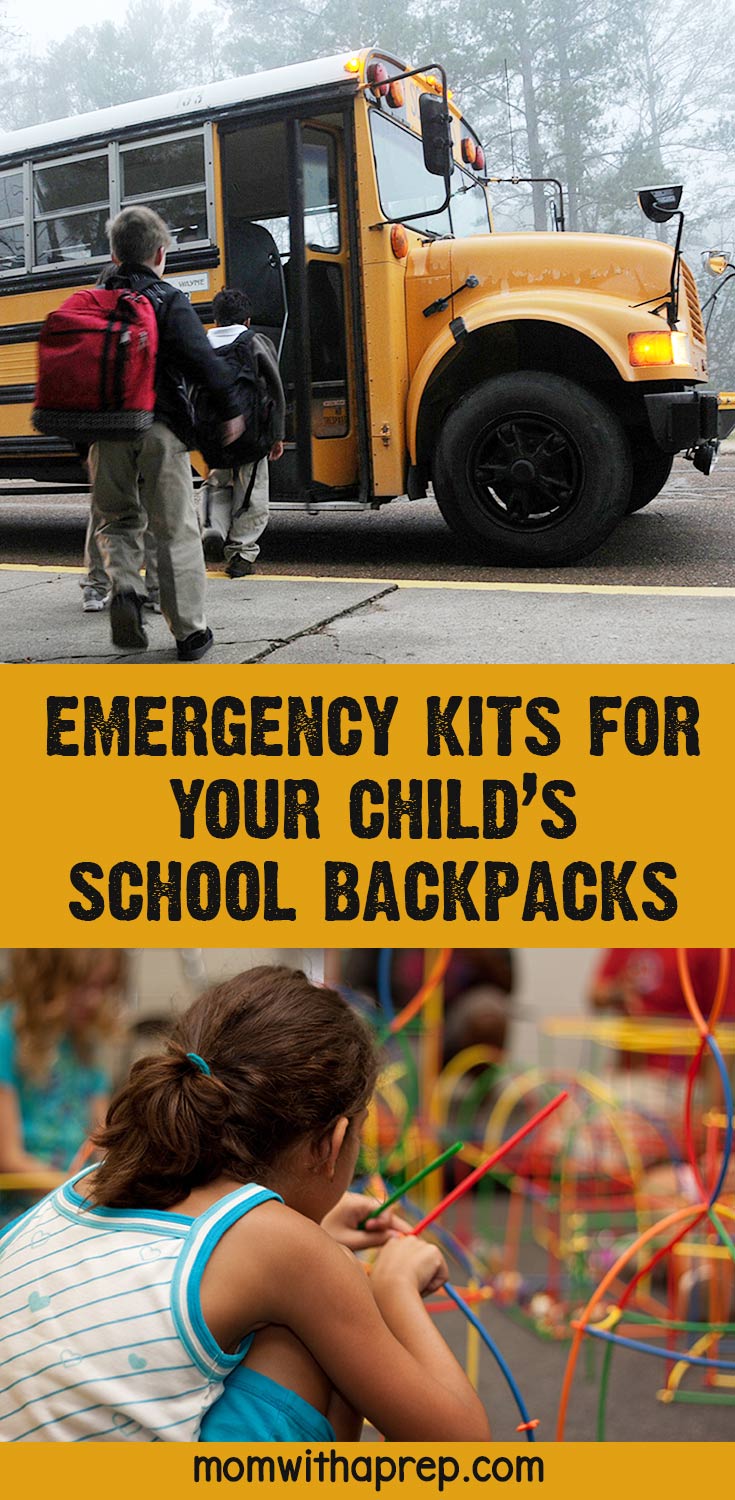One of our biggest concerns with having our kids at school, as folks focused on preparedness living, is that we won’t be there in a time of crisis to help them out. So it’s especially important to prepare our children the best that we can, above and beyond what the school is able to do for them, and what their Everyday Carry (EDC) can do. Check out this emergency survival kit.

Why Would You Even Need an Emergency Survival Kit? Don’t the schools provide enough?
- School lockdown
- Local Weather Emergency
- Regional Emergency
- Bus accident
- You don’t show up (or whomever their ride is) or their bus is wrecked on the way home.
From our experience, schools aren’t really prepared for long-term lockdowns or disasters. A classroom kit rarely contains enough water and food for an extended time for an entire classroom of children. So it’s prudent to help your child. We want to be prepared at all times especially when the life of our children is at stake. As adults, we want to be ready.
A Sad Example
Recently, I was in a classroom and saw an emergency survival kit laying on the floor. It was just tossed up against a corner. Because I was alone, and doing what I do, I decided to take a peek inside.
What I found was a sad example of what too many classrooms are doing.
The contents were as follows: A sleeve of saltines, a 12 oz bottle of water and 8 dixie cups, 2 bandaids, and a flashlight. Oh..and a magnetic window cover for the door.
Sure…this would work for a 20-minute emergency. But what if it were longer? What if we were looking at a natural disaster or a lockdown that lasted a day?
Or… what if this was a bus accident? There is nothing more than a simple first aid kit and fire extinguisher on most buses.
How Can We Help?
One of the ways we can help is to create an emergency survival kit for our kids. This can be something they keep tucked away in their lockers, at the bottom of their book bag, or in their desk or cubby at school. It needs to be somewhere easily accessible to them without breaking the rules of the school. It is also important to know what to put inside the emergency survival kit.
Items to Include in Your Child’s Emergency Survival Kit
- Water (these emergency pouches may be hard for your little ones to open so if you can, stick a small water bottle in)
- Protein Snack or Granola bar (or both)
- Small flashlight or headlamp
- Emergency Whistle (and don’t skimp on this — cheap whistles often don’t work or are not strong enough to be heard in a lot of noise. We made that mistake when we first created our kits and found out they just don’t work when needed).
- Cell phone (this may be an issue for some schools, but we would have our kids take a throw-a-way cell in their packs, just in case).
- Small first aid kit – and the knowledge on how to use what you’ve enclosed. This can be as simple as a few band-aids and a tube of antibiotic ointment)
- Emergency Blanket – while the cheaper mylar blankets seem a better buy, they are pretty flimsy and tear easily. This can serve as a poncho, something to sit on, to keep warm with, etc.
- Extra health-related items your child uses (of course we have to say for the attorneys….please be sure to follow your school’s rules for medication storage and uses……. )
- hard candies for comfort & energy
- Comfort item (small stuffed animal or toy to bring comfort in crisis)
- Chapstick and antibacterial lotion hand cleaner.
- Photo album – you can create a small photo album for your child to have photos of the family to help bring them comfort. It is also a great ID item in the chaos of pick up after to have a photo of you with them for rescue workers to help release to the appropriate guardian).
- Wipes – we put a small package of wipes to help keep them clean
No products found.
CLICK HERE TO PRINT OFF YOUR OWN EMERGENCY ID CARDS
Step it Up
For older kids or if you’re wanting to pack a better bag, here are items that may or may not be approved by a school district, and you can decide how you want to handle them.
- Firestarter (this kit is great – combines quite a few of the tools together! – flint laces, bracelet, compass, etc.)
You can store supplies in a zip-top bag, a small baby wipe box, a pencil box, or if you’re really good at packing small supplies, a large Altoid box!
Just make sure your younger children understand that this isn’t for play and that they aren’t to pull it out at snack time or recess, nor discuss with other kids that they have ‘toys’ in their packs.
Please also follow the rules of your school about what can legally be brought onto campus and what you can do about it. Only you can decide that for your child.
A Note to Parents
It was mentioned in the comments that generic supplies for a whole classroom should be the way to go and that it can be dangerous to have this only for your child. But what school really has all of these supplies on hand for all children? Not any that I know of. That is where our role as a parent kicks it. Their safety is our utmost priority.
As a parent, it’s my responsibility to make sure that my child has what they need, if at all possible. This goes not just for the classroom, too. If they ride a bus, these items may be useful for your child if there’s a bus wreck, or if they have an accident riding home from school on their bike. Take a look at the bigger picture and see how you can help your child and don’t rely on the system to do it for you. This will come in handy.
How Can We Support our Schools to be More Ready?
- Ask your child’s school about the readiness plan they have. Don’t be worried if they are a bit vague as they may not want to break security protocols. But pin them down on the plan that they can share.
- Talk to your child’s teacher about his/her course of action if the school’s is not great.
- Get together with your PTA or even just your own classroom and donate ready-kits for classes.
Yes, we want our schools, churches, daycares, and places that keep our children to be ready for emergencies … but don’t leave it to them to do it. Be proactive, teach your child HOW to use the items in their emergency survival kits, and give them the ability to be ready for anything.
Your Thoughts: What other items would you include in your child’s emergency survival kit?

Katy Willis is a writer, lifelong homesteader, and master herbalist, master gardener, and canine nutritionist. Katy is a preparedness expert and modern homesteader practicing everyday preparedness, sustainability, and a holistic lifestyle.
She knows how important it is to be prepared for whatever life throws at you, because you just never know what's coming. And preparedness helps you give your family the best chance to thrive in any situation.
Katy is passionate about living naturally, growing food, keeping livestock, foraging, and making and using herbal remedies. Katy is an experienced herbalist and a member of the CMA (Complementary Medical Association).
Her preparedness skills go beyond just being "ready", she's ready to survive the initial disaster, and thrive afterward, too. She grows 100% organic food on roughly 15 acres and raises goats, chickens, and ducks. She also lovingly tends her orchard, where she grows many different fruit trees. And, because she likes to know exactly what she's feeding her family, she's a seasoned from-scratch cook and gluten-free baker.
Katy teaches foraging and environmental education classes, too, including self-sufficient living, modern homesteading, seed saving, and organic vegetable gardening.
Katy helps others learn forgotten skills, including basic survival skills and self-reliance.
She's been published on sites such as MSN, Angi, Home Advisor, Family Handyman, Wealth of Geeks, Readers Digest, and more.
Last update on 2024-07-27 at 00:07 / Affiliate links / Images from Amazon Product Advertising API

